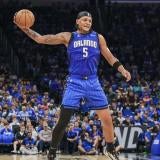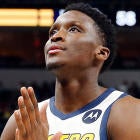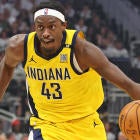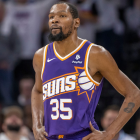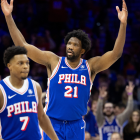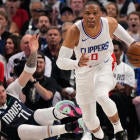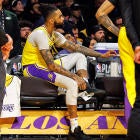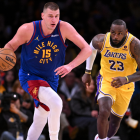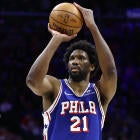On Thursday it was confirmed that Indiana Pacers All-Star guard Victor Oladipo will miss the remainder of the season with a ruptured quadriceps tendon in his right knee. It's the same injury that effectively ended Charles Barkley's career when he was with Houston in 1999. Tony Parker also tore his quadriceps tendon in the 2017 playoffs while playing with the Spurs. Those are the rare examples of NBA players suffering an injury that Dr. Rodney Benner -- a knee specialist and orthopedic surgeon at the Shelborne Knee Center in Indianapolis, as well as a team orthopedic surgeon for Purdue University -- told CBS Sports is "probably a little bit worse" than the more common ACL tear we often see in athletes.
This is obviously a devastating blow for a Pacers team that was looking like a dark-horse conference finals contender in the East. Yes, Tyreke Evans and Darren Collison are capable playmakers, and rookie Aaron Holiday, who one scout told me "could end up being that late-first-round steal" after he went No. 23 in last June's draft, will get a more extended opportunity to turn some heads. But let's not get it twisted: You don't replace Victor Oladipo on any roster, let alone this Pacers roster, which is composed of a lot of solid players but no other stars.
Oladipo was having a somewhat down season, scoring almost five points fewer per game than last season while shooting worse from both the field and 3-point range. But numbers only tell so much of a story. Oladipo's presence alone creates shots for guys largely incapable of creating them on their own, and his playmaking for others was one of the real strides he had taken this year. Oladipo's 5.2 assists per game were a career high, and his defense is always elite.
Where Indiana will miss Oladipo most is at the end of games. The NBA defines clutch games as being within five points with five minutes or fewer to play, and in those minutes, Oladipo was the No. 3 scorer in the league while shooting an incredible 63 percent from the field and 60 percent from deep. Not coincidentally, Indiana was 11-4 in those games. Indiana is not going to run away from many teams, and in the playoffs, not having that guy to create offense in those tight, end-of-game situations is a killer.
Below is a transcript of the interview CBS Sports conducted with Dr. Benner regarding Oladipo's injury and the arduous recovery process that awaits. In some cases, Dr. Benner's answers have been lightly edited for length and clarity.
CBS SPORTS: With the news of Victor Oladipo's season-ending injury, "ruptured quadriceps tendon" is probably being Googled like crazy. What, exactly, does that diagnosis mean?
DR. BENNER: The quadriceps muscle group starts all the way up by the pelvis and runs down the front of the thigh. At the bottom of the thigh, the quadriceps muscle attaches to the top of the kneecap, and that tendon where the muscle meets with the bone, that's the quadriceps tendon. In Oladipo's case, he tore that quadriceps tendon right off the top of the kneecap.
CBS SPORTS: This is a really rare injury to see in NBA players. Why?
DR. BENNER: It's just an age thing. Generally people who have quadriceps tendon ruptures are older folks. For whatever reason, with people younger than 40, the patellar tendon, which is below the kneecap, is the the more likely of the two to sustain an injury. That's the compelling thing about Oladipo's injury. He's a young man in the prime of his athletic career. He's just not in the normal range where we see a lot of these injuries. Nobody can really say why that is. For whatever reason, it's just what we tend to see.
CBS SPORTS: OK, so with a quadriceps tendon rupture, in terms of compromised functionality, what are we talking about?
DR. BENNER: Not being able to straighten the knee is really the diagnostic sign that tells us the tendon is torn, and the inability to straighten the knee does not allow for normal walking. Compare that to an ACL tear, where the knee can still function with daily activities and will only give out with cutting and twisting maneuvers. For regular people who don't have to play professional sports for a living, it is totally possible to tear your ACL and live a normal life without surgery, as long as you are willing to accept permanent activity restrictions. With quad tendon ruptures, that's not the case.
CBS SPORTS: You mention ACL tears. That's an injury every athlete and sports fan is familiar with and we all know how severe it is. Would you say this injury that Oladipo has suffered is worse than an ACL tear, or just different?
DR. BENNER: It's different, but probably a little bit worse. When I initially saw the injury, I started thinking about the potential bad injuries that happen like a patellar dislocation, an ACL injury, a quadriceps or a patellar rupture, even a patellar fracture -- actually breaking the kneecap. And of all those things, unfortunately the quadriceps tendon rupture (which is what Oladipo suffered) is the injury I would least like an athlete to have.
The reason is mostly a post-surgical difference. In the first six weeks after a quadriceps rupture, the knee needs to stay completely straight in a brace, and the options for bending the knee early on are pretty limited. Basically, all you can do for those first six weeks is some very gentle, minimal flexion, because if you bend the knee too much early on after surgery, you risk the tendon becoming disconnected again. You have to make sure the tendon is healed back to the kneecap, solidly, before you can begin any kind of aggressive rehabilitation.
After surgeries for a lot of those other conditions I mentioned, you can progress the range of motion and the return of function can come relatively quickly. For example, with an ACL tear, you can have the knee bend as far as your pain threshold allows, even at the very beginning of the rehabilitation. Even with the more common (among young people) patellar tendon rupture, in that case, you put the tendon back together, and then you have bone attachment sites that are very close to one another between the kneecap and the shin bone. They're only five or six centimeters apart. That allows you to actually put implants through the kneecap and tibia bones that can hold the tendon in place. That way you know it's secure and you can be a little more aggressive bending the knee early on after surgery.
With the quadriceps tendon, above the kneecap, there are no bone attachments that allow you to protect the tendon in the same way. All that's holding the tendon to the kneecap are some stitches, meaning you have to wait for it to heal back to the bone or risk the tendon tearing right back off. It delays the start of rehab for about six weeks, or until the doctors feel comfortable that the tendon has fully healed back to the bone.
CBS SPORTS: OK, so once Oladipo can begin full rehab, what will that entail?
DR. BENNER: It'll be pretty simple stuff early on, just gentle bending of the knee, likely with a brace that will allow him to gradually bend the knee more and more. As you can imagine, after your knee has been held pretty much completely straight for six weeks, it takes a long time for you to gradually work up to a full range of motion and fully bend the knee. Once the knee is bending enough to be able to handle exercises, they'll start light strengthening and biking.
Now, getting the range of motion back is only one part of the equation. Then you have to do the job of rebuilding the quad muscle. The quad muscle is a very strong muscle that maintains its strength by being used on a regular basis as we walk, as we exercise, all of the above. With the knee being held straight for the majority of those first six weeks, the quad muscle has very little activation and can get really weak. Oladipo's quad muscle is going to atrophy and decrease in strength pretty significantly. So that strength will have to be built back up.
Once full range of motion and good strength have been achieved, they'll progress to light agility drills, running, and basketball specific drills. The final stage will be gradually returning to practice and full participation. But that's a long way off. The part that tends to move pretty slowly is getting your full motion and all your strength back.
CBS SPORTS: Bottom line, do you expect Oladipo to make a full recovery?
DR. BENNER: The hard part is even if you get full range of motion back, even if you get all the strength back, there is that unknown part of the equation. Professional athletes have to put incredible stress on that muscle and tendon, whereas a normal person who sustains this injury, they're just looking to restore continuity of the muscle and get as much of the motion and function back as they can. They want to walk normal. Things like that. Victor Oladipo is an incredibly explosive and dynamic athlete. That's one of the things that makes him so special. So he has loftier expectations, or a higher bar if you will, for his recovery.
From a medical standpoint, the tendon is going to heal. If he is able to get his full motion and all the strength in his muscle back, he will be able to return to the explosive athlete he's been. But the thing is: it's hard to recover all that. There is no question that there are some aspects of an injury that might be insurmountable. Results differ from person to person, surgeon to surgeon, athletic trainer to athletic trainer. You just don't know until you get into the rehab and see how the athlete responds, and really, once he's back out there competing and being explosive and athletic.
Also, for the athlete, getting back the same level of strength and range of motion and all those things isn't the only hurdle with an injury like this. It's the mental part, the confidence to jump and land and explode the way an athlete like Oladipo is used to doing. Now, Victor Oladipo seems to be hard working and a really mentally strong guy, so I would say all indications would point to him being able to make a full recovery. But there is an unknown factor with an injury like this.
CBS SPORTS: OK, if you think a full recovery is likely, what about a timetable for his return to the court?
DR. BENNER: I think the goal would be to have him ready for the beginning of the [2019-20] regular season. I think that's a reasonable goal to try to hit. As doctors, we're always trying to set expectations for athletes that are lofty, that will keep the athlete motivated to do better and keep the recovery aggressive, but that are also realistic. You can't just expect that the recovery is going to go all according to plan, so you find that middle ground. October, to me, is a good middle ground. If I was Oladipo's doctor, I would tell him let's shoot for game one to start next season. If we get there, great, and if we don't, it shouldn't be long after.
CBS SPORTS: Being an Indiana native, you've done a great job remaining objective in your medical analysis. But you're invested in Oladipo and this Pacers team as a fan, too.
DR. BENNER: No question. As much as everyone loves the Colts in this town, basketball is king here in Indianapolis. People love the Pacers, and Vic is such a huge part of that. He's obviously a great player, but he's such a dynamic personality in the city as well. For a guy that went to [Indiana University] -- again, there are a lot of IU graduates and fans here in Indianapolis -- to come back here and do what he's done with the Pacers, kind of that hometown guy, the connection between him and the city and really the whole state is so strong. I really believe he's on his way to getting to Peyton Manning and Reggie Miller status here in Indianapolis. You just hate to see this happen to him when he's on that trajectory. You just hope that things go smoothly for him, that he doesn't have any setbacks and that he's able to get back to being the dynamic player he is.













